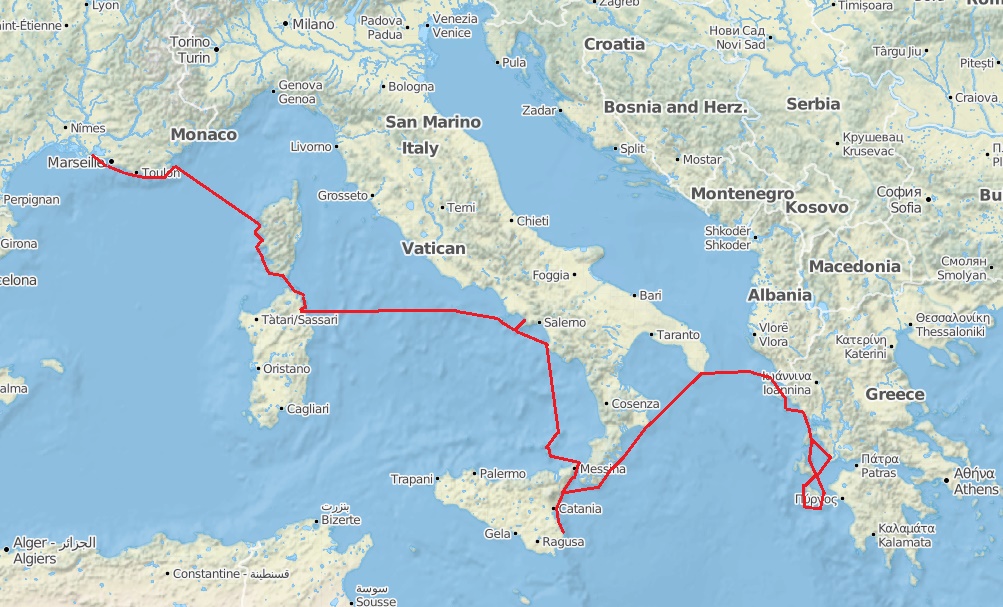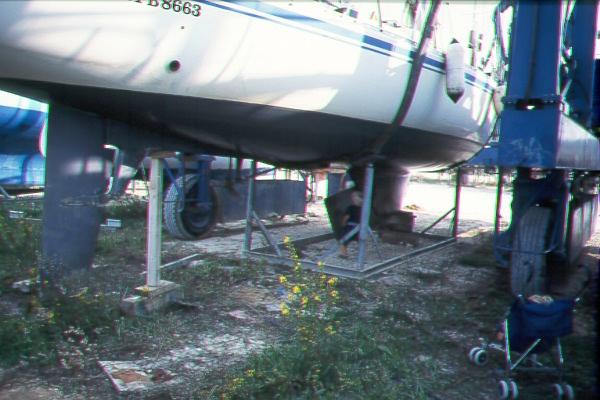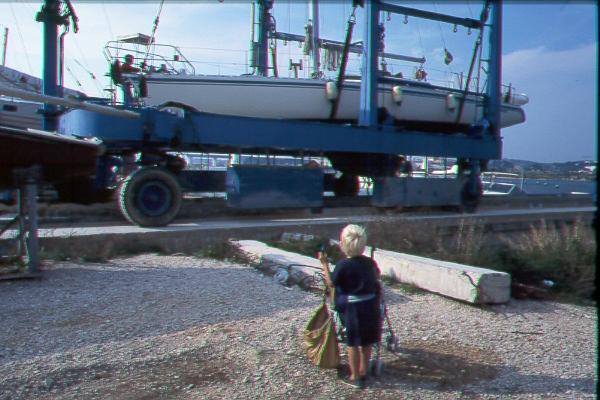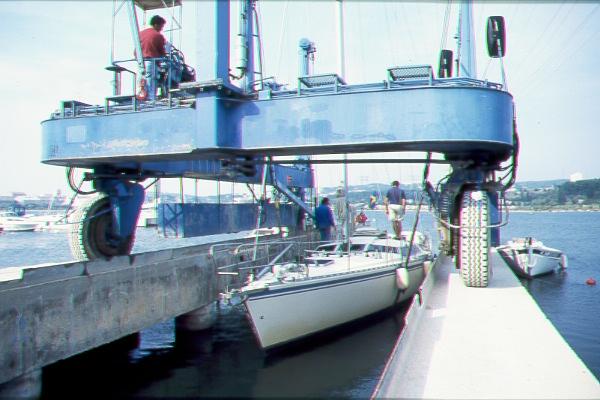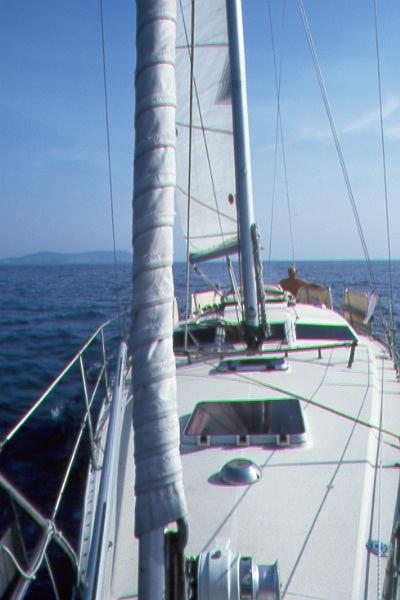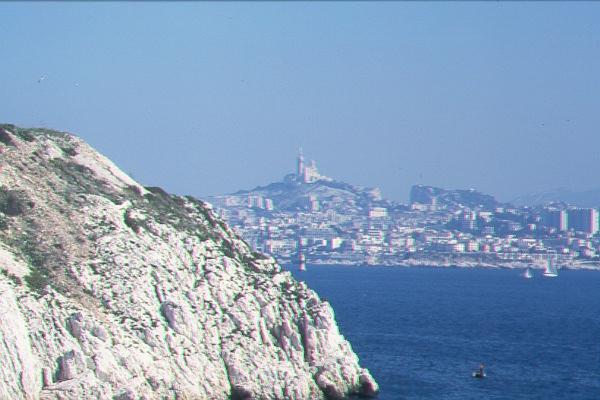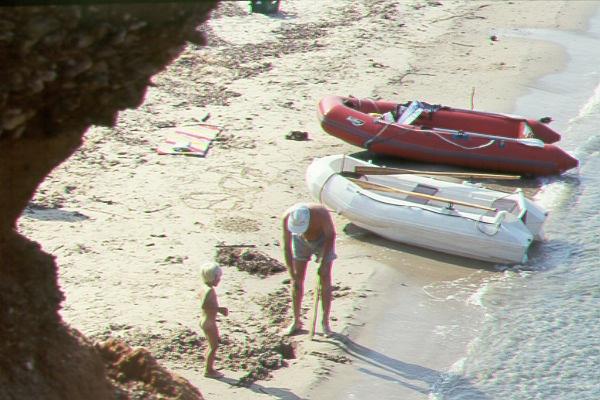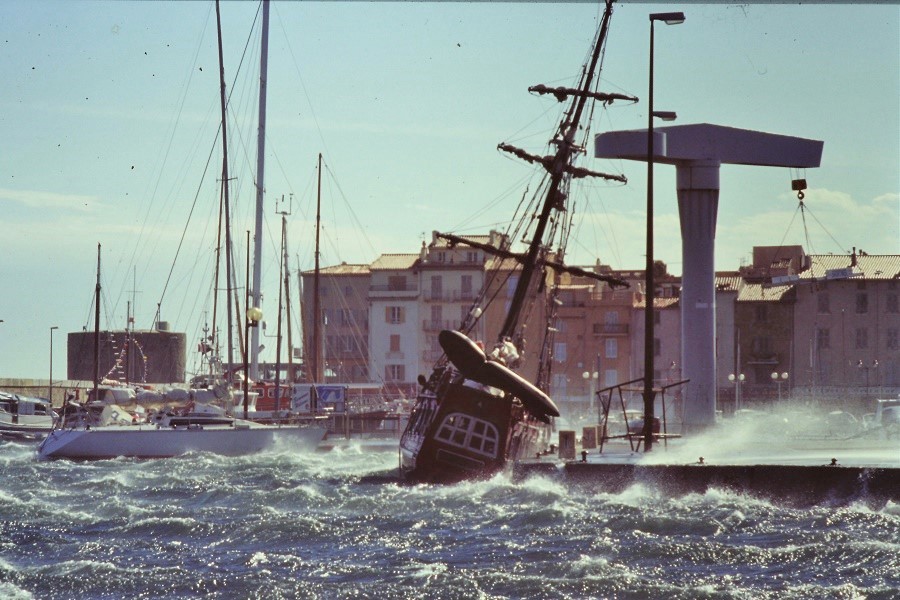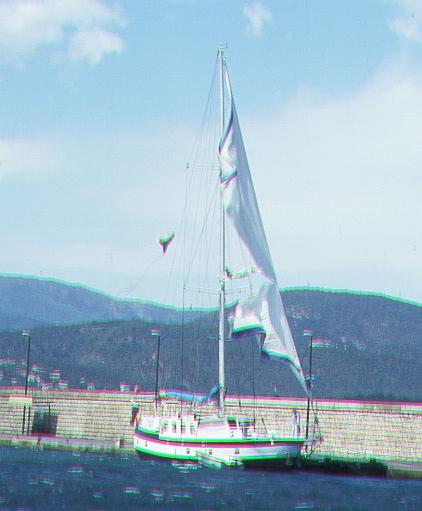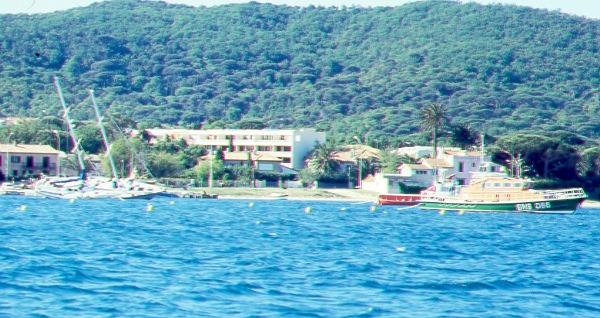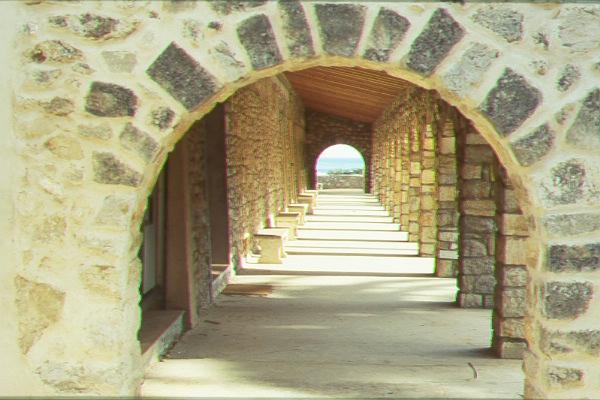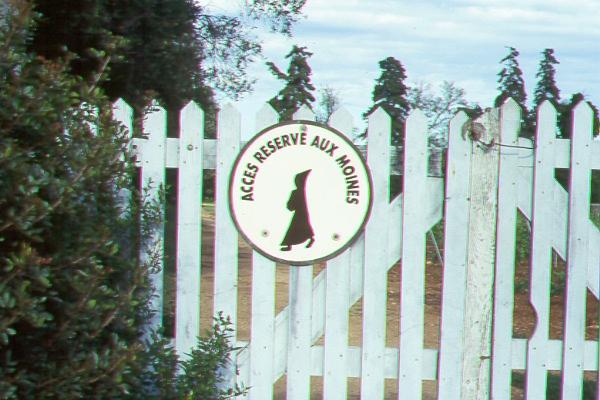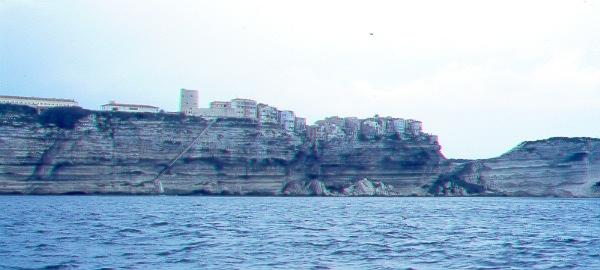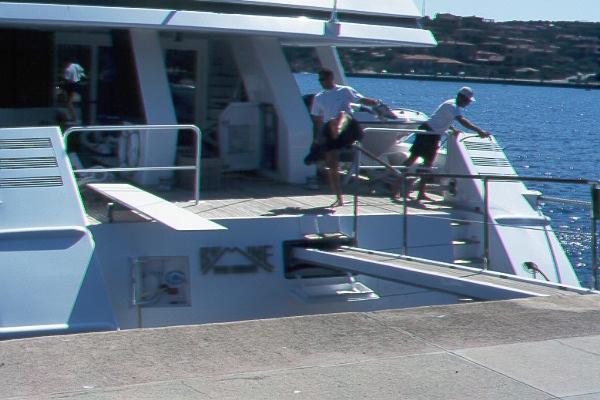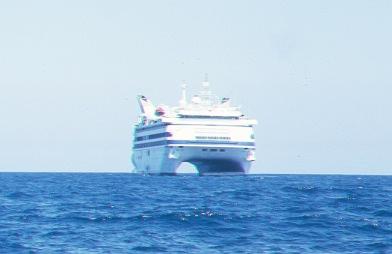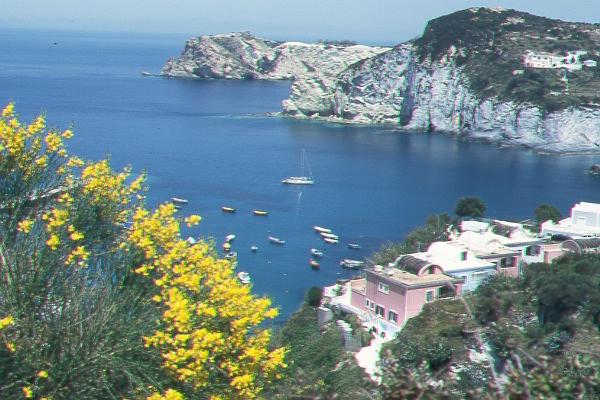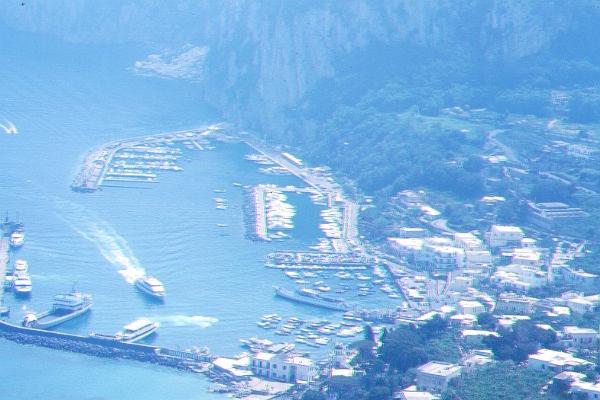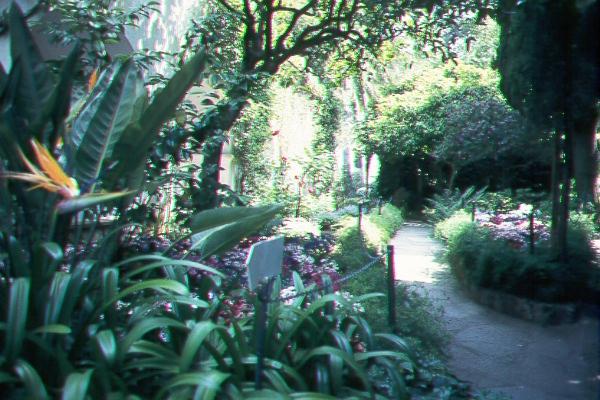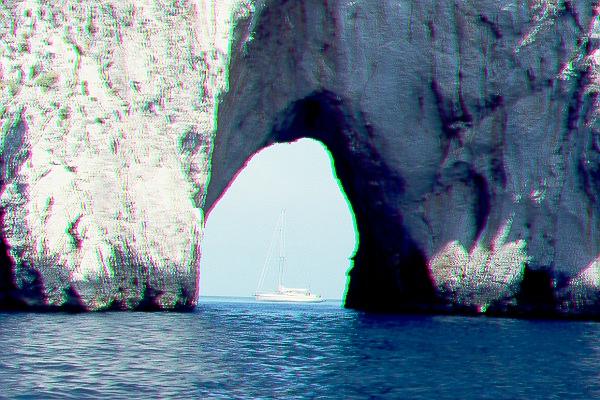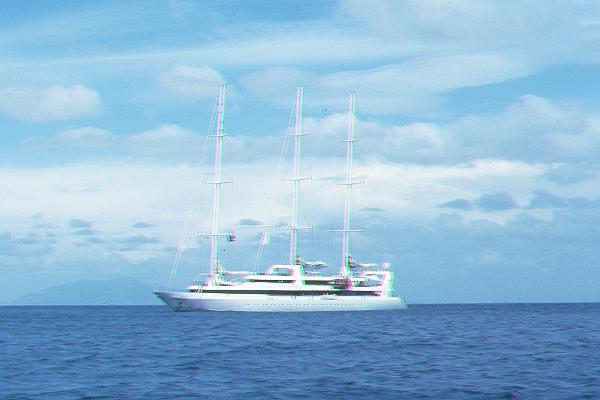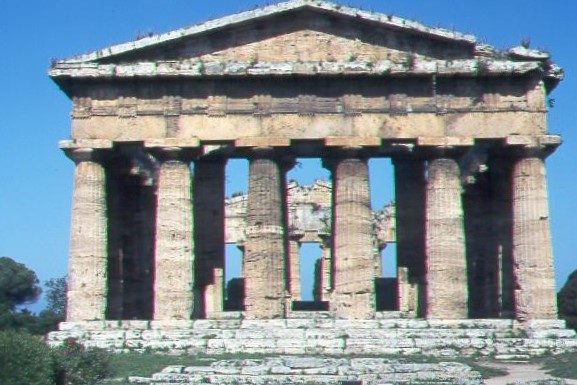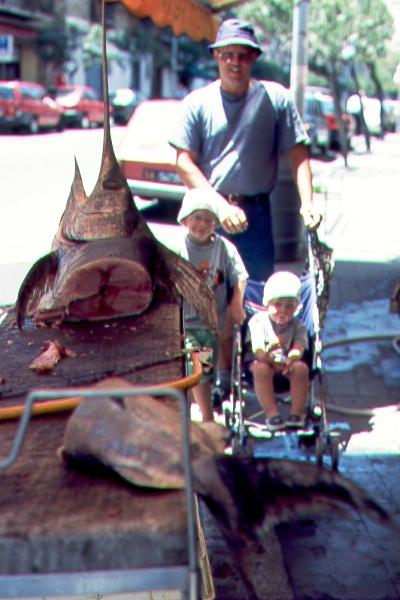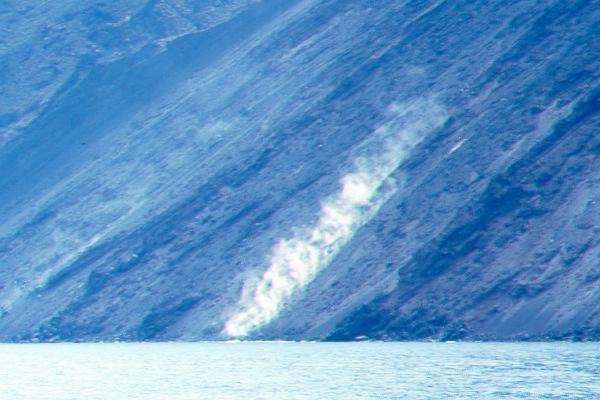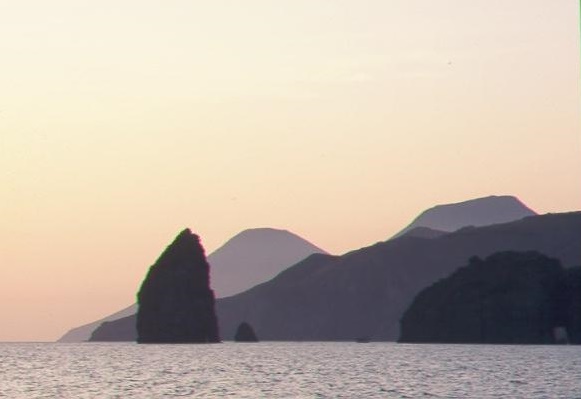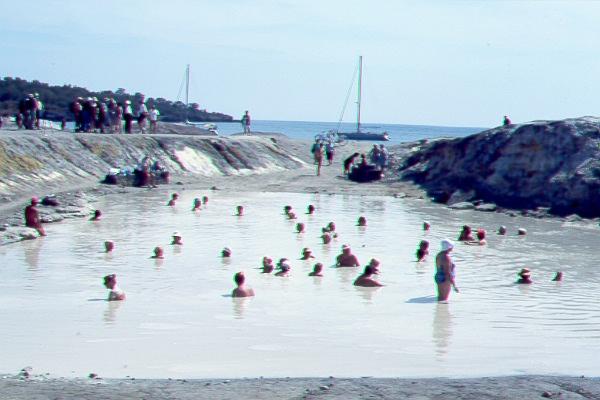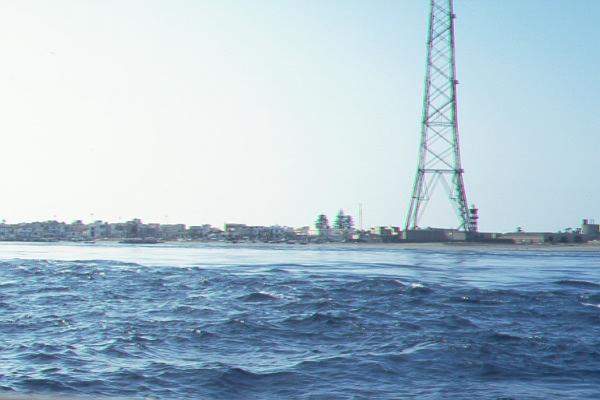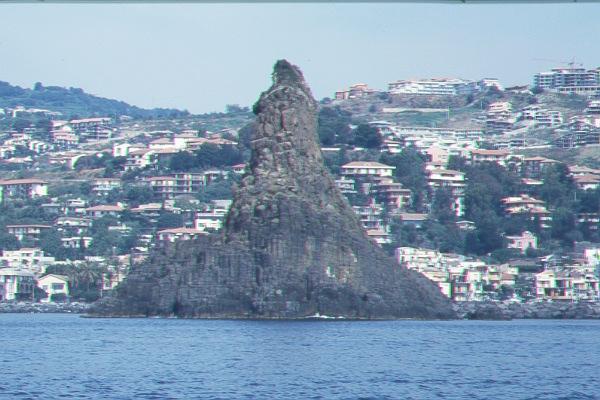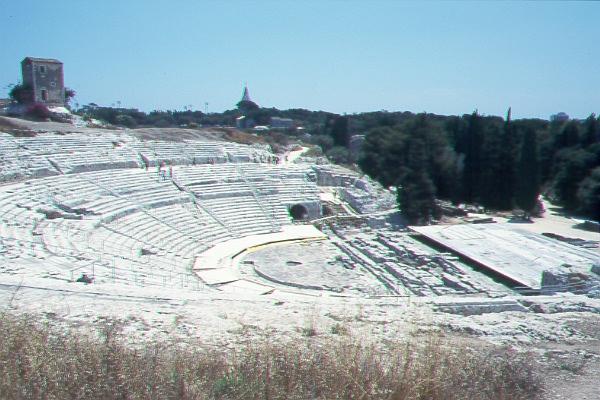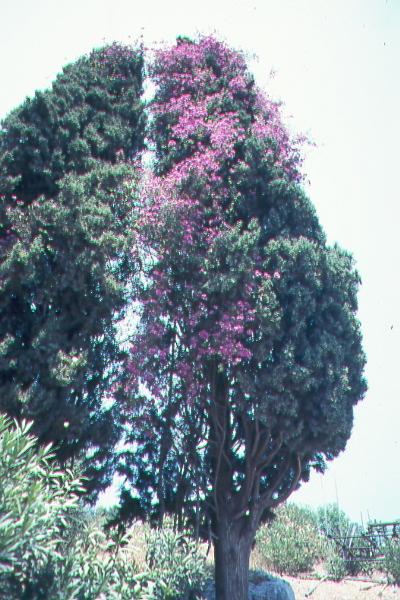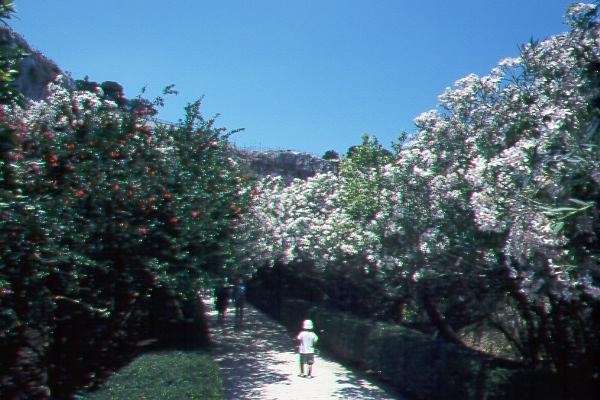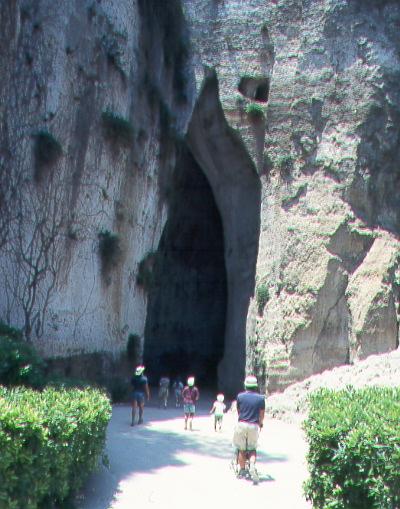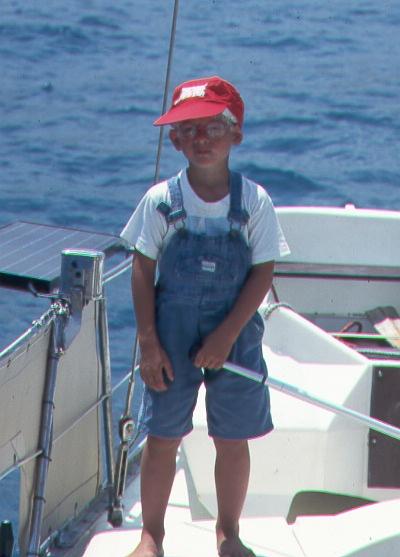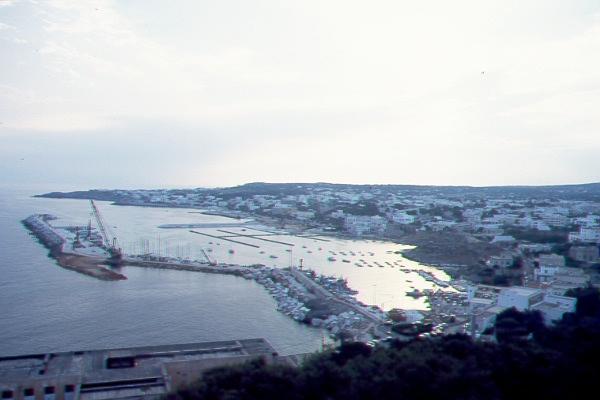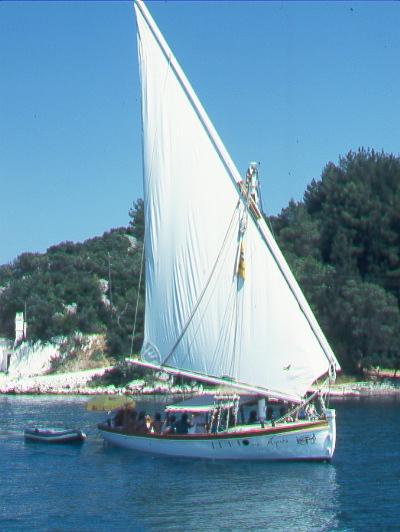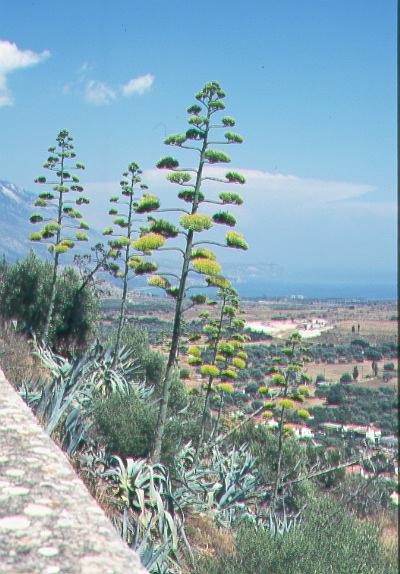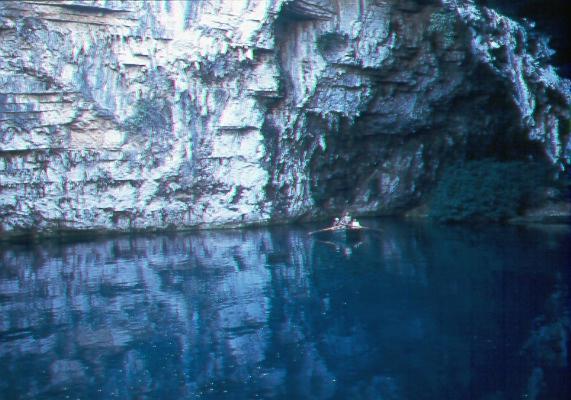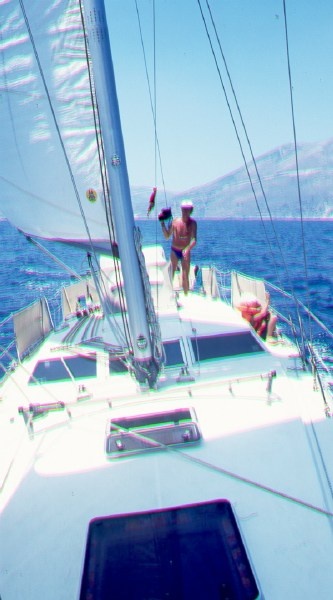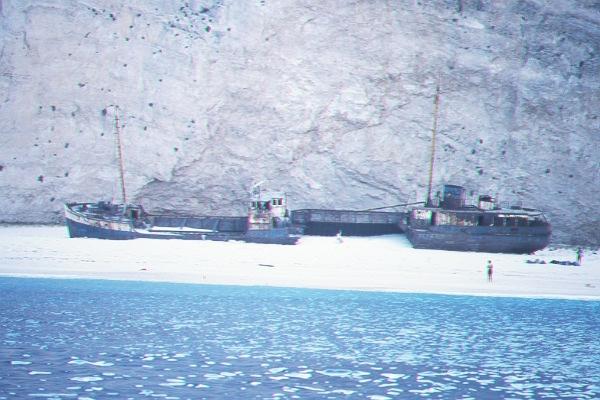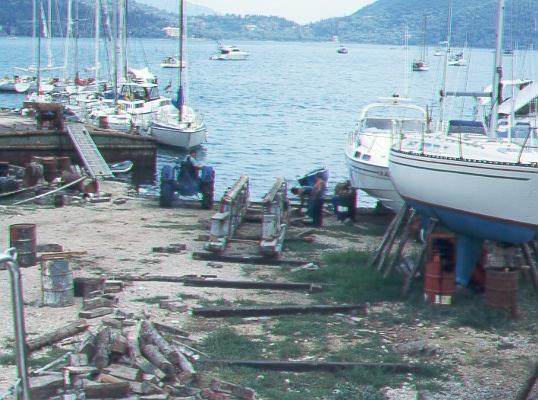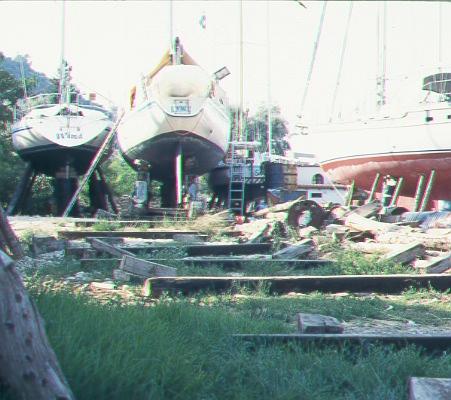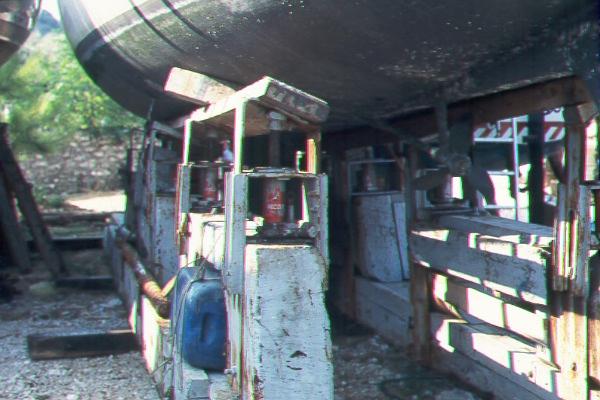
 1995
1995


From France to Italy and Greece
France, Corsica, Sardinia, Sicily, Italy and Greece by Johan Kjellander 1995-2014 På svenska
In May 1995 we launched Lynx from her winter quarters in Martigues, not far from Mareilles. From there we sailed along the French Riviera and then to Corsica and Sardinia. After that we crossed to Italy, visited the Liparian Ilands and Sicily and finally continued to Greece where we spent a few weeks before we left the boat on land and returned to Sweden in August. By the end of the season our log read 1570 NM.
Tove took the pictures and from about 500 images we have selected the following. I wrote the texts.
France
We took our newly purchased (well-used) minibus from Sweden in late April and met the summer in northern France. The shipyard in Martigues is huge with lots of interesting boats from all over the world. Plenty of people who are either on their way out of the water or on their way into the water. One can stay aboard a week or two before launching if you want to. Showers and toilets, water and electricity are included in the fee, which is approximately SEK 1000/month in advance for a 10-meter boat including haul out and launch. The mast is not removed.
Many we meet at home have asked us if it is safe to leave the boat in this way. The answer is unconditionally YES! There are plenty of well-guarded and safe boatyards around the Mediterranean. In Martigues as well as in many other places, they use travellift. A travellift is a self-driving lifting crane with 2 adjustable straps that lifts the boat from a special pocket in the quay and then carries the boat to its hardstand. Often there is also a forklift that supports by moving cradels etc. Fast and smooth and without a scratch on the boat. The staff prefers not to recieve any help and that is not needed either.
Now we are soon in the water again. The time at the shipyard is a fun part of sailing life especially for the children. They can meet other children from other countries and although they do not understand each other's language it is fun to play anyway. The sign language and their unsurpassed sense of communication are quite sufficient. I am thinking in particular of Cecilia 3 years born in Cyprus with cruising parents originally from Brisbane in Australia. For a couple of weeks she played with Martin and Gustav and they became real friends. A lot of crying when our roads split. All the sad goodbyes is the downside of sailing.
Now it is just to start up the engine and go the quay outside a couple of days to make the last preparations. Then it is farewell to everyone you learned to know and then go on with new adventures.
Finally in the water again. Unfortunately, there is often too little wind in the Mediterranean and you have to take the engine to your help if you want to get anywhere. To sail 1-2 knots when you have several hundred miles left to go is just not an option.
Marsielle, or the town of thiesf as it is also called. We stayed a few days in the Vieux Port (Old Port) to look at the city. Tove sent me to the food quarters to shop and I rode away on my bicycle. The quarters looked a little rough but I didn't think so much about it. I found a good supermarket and parked the bike outside. I barely had time to descend before the staff came out and dragged the bike into the shop. Out there, they said, it cannot stay, then it disappears immediately. I did look around both once and twice when I drove away with my grocery bags, but I didn't see any crooks.
East of Marsielle is a stretch of fine cruising area. First the so-called Calanks, les Calances, small fjords with high mountains all around. Then Les Porquerolles or the protocols as we called them. A group of islands with fine sandy beaches and good anchoring. Here we spent time with our friends in the Swedish Allegro 33, Yolanda.
St. Tropez. We first anchored in the bay where Brigitte Bardot's villa is located but then we were warned of bad weather on the Navtex and chose to go into port. Expensive but thanks for that. An unusually powerful Mistral came dragging along in the evening and continued throughout the next day. The mistral is a strong wind that blows from the northwest out over the sea and comes as fast as it ends. 20 m/s is normal. 30 m/s not unusual and sometimes worse. During the second day of the afternoon, it blew so hard that you couldn't even breathe with your face against the wind. Standing up was not to think about. The wind speed sensor of the boat next to us blew into pieces and got stuck at 53 m/s. The birds took shelter under cars and park benches. Sails blew apart. Boats drifted up on land. It was a total chaos.
This picture gives an idea of what a drama it was. The small red boat was breaking up against the quay but at the last moment a pickup loaded with car tires came to rescue. The plastic boat to the left of the red boat banged into the stone wall and got a large hole in the bow.
If you do not furl your genua properly in the evening, you might get into problems. This boat lost its entire genoa in just a couple of hours. The owner was in despair and did everything he could but it was too late. If the wind gets hold of just a small piece of the sail, there is nothing to do. In the end it was just the forestay left. We did well ourselves apart from one of the fabric sides around the cockpit that blew apart. In addition, thick salt layers everywhere. The sea lifts several meters in the wind and dries immediately when it hits an object in the hot air. After a few hours it looks like the rig is completely full of ice.
This boat had anchored just outside the marina. It ended up on the beach. Two tugs were required to pull it off. One pitched down the mast and the other one pulled. The stranded boat moved only a few meters forward. The tug pulled again. Then over and over again. Every time the stranded boat moved a little. In the end she started straightening up and then she was afloat. Luckily, there were no serious injuries.
The next day everything was as usual. We sailed on in a weak wind towards the islands outside Cannes. We were very worried about our friends on Flora Ella, an australian boat with an older couple who stayed in Brigitte Bardots bay when we left it to go into the marina. Guess if we were happy when we suddenly met them again. They had gone to Port Grimaud (the second port of St. Tropez) an hour after we left them to seek shelter from the mistral.
On one of the islands there is a monastery that is open for visits. Incredibly beautiful with many fine old buildings and a stunning garden.
We just had to take a picture of this sign. Access only for monks.
From Ile St. Honoret outside Cannes we now aimed at Corsica. An island with high mountains that still had snow left on the highest peaks. Corsica belongs to France but has a rather active resistance movement that wants to cut the ties to the motherland. We stopped here and there along the western side of the island on our way south, including in Ajaccio, the island's capital.
On the southern tip of the strait between Corsica and Sardinia lies Bonifacio, a very old town strategically located high up on the cliff above the beach and with a naturally protected harbor in a deep bay surrounded by steep mountain slopes.
Italy
We crossed the strait of Bonifacio and continued south but now along the eastern side of Sardinia. Soon you will pass Porto Cervo, the celebrity's paradise. Here, for example. Aga Khan and Rod Stewart cottage. It is also a center for racing with events such as Sardinia Cup eg.
You can feel the smell of money when you approach and mooring in the harbor is not to be considered if you do not want to spend your entire budget. We anchored and took the dinghy ashore while the millionaires stared at us. Check out the small motorboat on the picture. Telescopic gangway that is pushed out of the transom and at the end of the gangway sits a door phone! Trampoline for bathing and a number of watercraft plus several larger dinghies with outboard motors of over 100 horsepower. Staff polished and polished.
Outside the entrance to Porto Cervo, this mega catamaran lay waiting. Lifeboats were in shuttle service with the passengers entering the harbor.
The town of Olbia just south of Porto Cervo was the last stop in Sardinia. From there we went to have a look at the Pontinian Islands outside Naples on the Italian mainland. The first island is called Ponza. In the picture we have climbed above the small village on the north side of the island and down there in the bay lies Lynx on her anchor. In the foreground bushes of broom.
At the bottom of the bay is a fine sandy beach and also large beautiful caves that the sea has hollowed out of the gorge. One can row into the caves with the dinghy and that of course was exiting for the kids.
Via Ischia we continued to Capri which is a special island for us Swedes through the famous social doctor Axel Munthe's house with a large garden high up on the cliff and the whole plant is now museum. The house is called San Michele and he wrote a famous book about its creation (The Book of San Michele).
The picture is taken from the top of one of his balconies down to Marina Grande harbor. Unfortunately, the air, like so often in the Mediterranean, was not very clear.
The garden of villa San Michele. Axel Munthe even planted a couple of birches here. We found them but they were not much to see. It was obvious that they did not thrive in this climate. Neither birch, spruce or pine grows naturally around the Mediterranean.
On Capri's south side, this beautiful cliff protrudes from the water. Il Faraglioni is the name and we launched Tove in the dinghy on one side of the vault while we went around with the boat so she could get some pictures. The vault is about 10 meters wide and slightly higher. Smaller boats passed straight through!
Yet another unusual sailboat. I wonder what LYS rating it has with its long waterline? There is a lot of cruise ships in the Mediterranean but most of them look more normal. Norwegian ships with asian crew are becoming commonplace.
On the Italian mainland just south of Naples is a 2,500-year-old Greek temple area named Paestum. There are remains of 7 temple buildings of which this is one. Theaters, homes, streets, etc. As beautiful as the Acropolis in Athens, but not as well known. We took the bus from the port city of Agropoli and climbed a whole day among the ruins.
The kids ran in the aisles under the theater where once the tigers were released and fantasized that they were gladiators with swords chasing the wild animals.
On our way home from Paestum we took the opportunity to buy some dinner. Swordfish is a delicacy that we eat as often as we can and can afford. Unfortunately, it is quite expensive as well as all the fish in the Mediterranean. Even lamb meat is cheaper. The only thing that is really cheap is octopus, especially the smaller variety (squid) sold for 15-20 SEK / kg on the markets. Octopus we have also learned to appreciate, and you can eat as often as you like. Fried, grilled, boiled, or marinated with baguette and a glass of red wine is not bad.
We left the mainland and once again sailed south, now to the Lipary Islands. The first island you see is Ingrid Bergmans Stromboli where she recorded the famous movie with the same name. On the way there we got a big fish on the hook. A nice Bonito but just as I was pulling it over board I lost it. Oh what a pitty. Three days of good food gone!
We anchored 10 meters from the beach and went ashore on the black lava sand. Stromboli is still an active volcano and lava sprays regularly from its top and runs along a lava field straight into the sea. We sailed close by and the picture shows how the smoking lava moves down to the water.
This beautiful picture Tove took in the strait between Vulcano and Lipari one evening when the sun went down. The sunny air gives a special light to the landscape.
On Vulcano there is this muddy, disgusting sulfur bath where people voluntarily went in and sat for hours. It smelled so bad that you almost got sick of it. We anchored in the bay outside but when the wind turned in the middle of the night and brought with it the sulphurous vapors out to the boat we woke up and had to leave..
Vulcano is otherwise a very beautiful island with a relatively easily accessible crater where you can go and look down. The crater always pours out smoke and sometimes it makes small ash and lava eruptions.
After the Lipary Islands, it was time for Sicily. We went down through the Messina Strait with the notorious swirls. Here Odyssefs once sailed and fought against Scilla and Karybdis. It wasn't that bad, but certainly the water moved around and the autopilot almost went crazy.
This phenomenon is due to the fact that the northbound currents bring with them relatively saltier water which, when coming out of the Messina strait due to its higher density, sinks down to the bottom. The swirls occur when the water sinks roughly in the same way as when pulling the stopper out of the bathtub.
A little further south along the eastern side of Sicily lies Achitressa. A small nice fishing community with a number of strange rock formations just outside the harbor entrance. In the picture one can see one of them. According to legend, it is the boulders that the blinded Cyclops threw after Odyssef and his men when they escaped from his cave hanging under the stomachs of the cyclop's sheep when he released them in the morning.
We continued slowly down the coast of Sicily via Taormina to Syracuse, the birthplace of Santa Lucia. A beautiful city with many attractions. On this picture you can see the old Roman theater which is exceptionally well preserved.
A beautiful purple bougainvillea climbing on a tree. Bougainvillea is a climbing bush that is found all over the Mediterranean and blooms intensively throughout the summer. Many have it in their gardens and let it cover the house's facade.
A flowering lemon grove. Cool and nice in the shade and a lovely smell.
Dionysos cave on the outskirts of Syracuse. The cave is shaped like an ear canal and if you are in the right place and whisper the sound can be heard in a completely different place far from it. The Swedish ear doctor on the boat next door went there with his family so we took company.
Now it was time to leave Sicily and head east along Italy's southern coast towards Greece. Warmer and warmer it became and the sunlight in the middle of the day is really nasty. Martin is now 5 years old and is starting to take an interest in the boat's care. Here he is very proud to steer out of a harbor somewhere on or way.
The last port in Italy was Santa Maria de Leuca. Here you see the harbor from the top of the Mussolini staircase. A long staircase that extends up the mountain side and which Mussolini built as a symbol of Italy's imperialistic ambitions eastward.
Many sailors heading to or from Greece come this way and we met several that we knew from earlier. From Santa Maria de Leuca to the Greek island of Othoni just north of Corfu, it is only 60 nautical miles, so if you start out early in the morning you are there before dark. Said and done. When the sun went down there were at least 20 boats in the little bay at Othoni and we were one of them. Imagine, finally, in Greece.
Now we had just over a month left before hauling the boat out again. We had made a reservation with a small shipyard in the village of Vliho on the island of Lefkas a bit south of Corfu so why not go south now and see what it looked like. We also had a date to match. A couple of friends from Sweden had flown to Marsielle a week earlier and were on their way to Lefkas with our minibus. They would come with us sailing for a week or two.
Greece
Tranquil Bay, just opposite of Nidri on Lefkas. A small Greek tourist boat in classic style with Latin rig. Right next door is Vliho where we would leave the boat for the winter both this year and next. So during three seasons we were in and out of these waters. It is not so strange that it became like a second home to us. The Greeks are very nice people and we enjoyed it very well here. A little too hot it was, at least in July and August.
We cruised the Ionian island world for a few weeks. Stopped here and there as it suited us. Islands like Corfu, Paxos, Ithaka, Keffalonia and Zakynthos. No stress and guaranteed good weather all the time. At Keffalonia we rented a car one day and drove around and explored the island.
Here the Agaves are in blossom. A cactus like plant that according to rumor only blooms once in 50 years and then dies.
One of the attractions on Keffalonia is this partially water-filled underground cave. No one knew that it was there until an earthquake opened up the roof and exposed what was underneath. To the left in the picture you see the sunlight coming down through the hole in the ceiling and to the right you can see how the aisles continue into the mountain. If you want to, you can go with the small boat into the aisles and look at the rest of the cave.
We picked up our Swedish sailing friends at Lefkas as agreed. The trip with the minibus from France had gone well. For more than two weeks they were on board among the islands and we had a wonderful time together. When they left us they first took a passenger boat to Athens and then flew home to Sweden again.
Here, Tommy is holding the rudder and also filming with his video camera. It is nice with a light boat in the Mediterranean because it often blows very little in the summer. (Exceptions exist). Many cruising boats are unfortunately quite heavy with all equipment.
We sailed around Zakynthos, the southernmost island in the Ionian world. At the south tip there is a very long deserted sandy beach which is one of the few Mediterranean places where sea turtles come and lay their eggs.
On the west side of the island there is this inaccessible bay where a ship was thrown up in the sand during a storm. We called it Wreck Bay. It is a well know motif, you can find it on postcards in almost all the tourist shops. The only way to get there was from the sea and when we sailed in early one morning there were already people there who obviously had stayed overnight on the spot.
In the end it was time to haul out the boat at the small yard and start the long journey back to Sweden. The shipyard in Vliho on Lefkas is an old shipyard that is run with ancient methods. The boats are taken up on a wooden sleigh that is pulled by a winch and a wire on simple wooden blocks. Once up on land, the boat is supported by rough cut wooden poles, and if it is a larger boat even by empty oil barrels. When you first saw it, you really wondered how it could work, but after 2 winters here we can state that it is one of our dearest memories from Greece. Nice people with personal service. Maria, who manages the office, is even the representative of the Swedish Cruising Yacht Club.
There is space for about 200 boats if you pack them tight. Many of them are Swedish so here we made many new friends, also the children. Vliho is a quiet and nice little place but just next door is the tourist village of Nidri where everything is open late in the night.
Then the boat is up. Now it is supported and then the two halves of the sleigh are disassembled and pulled away. 20 meters to showers and toilets. Water and electricity. The car parked inside the area 10 meters from the boat. It couldn't be better. Walking distance to restaurants and small shops. Cost roughly like in France ie. about 1,000 SEK / month for a 10-meter boat incl. haul and launch.
If you need help with something on the boat, they fix it during the winter at humane prices. You can for example ask them to prepare the boat and launch it before you come. Then you take charter from Arlanda to Lefkas and can then sail there the next day without delay. We went by car and had plenty of time so we took it easy and took care of the boat ourselves.
The sleigh is a simple wooden construction with two long boards at the top on which the boat rests. The boards are pressed against the hull by a number of small manual jacks, which are pumped up until the boards follows the shape of the hull. There are more modern shipyards at Preveza but hardly nicer or cheaper.
It rains a lot during the winter in this part of Greece. People warned us to make sure the boat was watertight from above and we heard nightmare stories about a Hallberg Rassy that had taken in so much rainwater one winter that it was almost filled. In the end, it did not cope with the weight, and split in two halves! I mounted a drain plug and left it open for safety.
It takes a few days to close down the boat in the heat and you also want to have some fun the last days before you go home. In the end, however, it is time. Martin will start school and for Tove and me job is waiting as usual.
